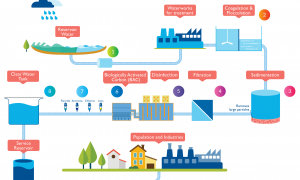🕑 Reading time: 1 minute
Dam failures rarely occur, but when they do, it wreaks havoc into the environment and human life. There are several reasons that contribute to dam failure like overtopping, failure of foundation, erosion, improper maintenance, etc. Modern dams make use of the latest design technologies that make them less susceptible to these failure factors.
Still, some of the major reasons that contribute to the failure of modern dams and their failure rates are explained below.
Contents:
Causes of Failure of Modern Dam
The major factors resulting in the failure of modern dams are:
- Overtopping
- Inadequate Spillway Capacity
- Internal Erosion
- Foundation Failure
- Outdated Designs
1. Overtopping
When the water flows into the reservoir in an amount that exceeds its intended capacity, the water is likely to flow over the top of the dam. The phenomenon is called as overtopping, which is the foremost reason for the failure of most of the dams. Overtopping causes serious damages to the dam, which worsen in embankment dams. Most of the embankment dams fail due to overtopping.
Read More: Embankment Dams

et.geoview.info
Most of the dams that fail by overtopping are usually the ones constructed in the olden era. This means the modern dams are less affected by overtopping.
2. Spillway Capacity
The failure of dams due to inadequate spillway capacity is another major cause that influences overtopping. The issue, to some extent, can be resolved by the way the dam is operated at the state of emergency. Modern dam construction technology and studies follow standard precautions and procedures under various situations.
3. Internal Erosion
Internal erosion is the removal of soil particles due to the high velocity of water seeping into the dam. Erosion of soil basically increases the width of the channel, which then allows an increased amount of water entering into the dam. After a limit, when the influx of water exceeds the dam's capacity, it leads to the failure of the dam.
4. Foundation Failure
The failure of a dam due to issues with its foundation is one of the most feared and dangerous types of dam failure. The foundation undergoes defect while supporting the dam structure. The weight of the dam has a strong impact on the ground below the structure. This weight can bring unequal settlement of the ground. These instabilities to the ground would bring the movement of the foundation. Earthquakes, high uplift pressures, and uncontrolled foundation seepage affect the foundation adversely that result in the failure of the dams. One-third of the dams fail due to their foundation defects.
5. Outdated Dam Designs
Within the past century, the design of dams has improved greatly. But, there are still communities around the world that are not able to afford to construct dams with the latest technology. Employing outdated design hence would be one of the reasons for the failure of dams.
Read More: Causes of Failure of Dam Structure
Dam Failure Rates
Roughly 1 in 10,000 dams undergo failure per year. This is more common in smaller dams. The failure of the dam occurs periodically in countries with less standard and strict engineering regulations. Most of the modern dams have failed either due to the severe effect of overtopping or high spillway erosion.
Every dam does not follow the same risk factor of failure. Any important geological detail that is not determined during the site exploration is shown during the first filling of the dam (The first time the reservoir is filled to capacity). So half of the dams fail during the first filling. The other half occur more or less uniformly in time during the remaining life of the dam. So, if the rate of failure averaged over the whole life of a dam is about 1/10,000 per dam-year, the rate during the first, say, five years reaches almost 1/1,000 per dam-year, or ten times higher. This is exactly what the historical record show.
The recent failure of Ore dam in Oreinte Novo district, Rondonia, Brazil on March 29, 2019, due to the damage of inactive tailings after heavy rain left almost 100 families isolated. Tailings dam is an earth-fill embankment that is used as a storage area for the byproducts of mining operations. The tailings can be solid, slurry or liquid which are highly toxic and radioactive materials. Another failure incident occurred in the Mount Polley mine (tailings dam), Columbia, Canada, where a dam collapsed due to the failure of the foundation on August 4th, 2014.
Read More: Failure of Gravity Dams


